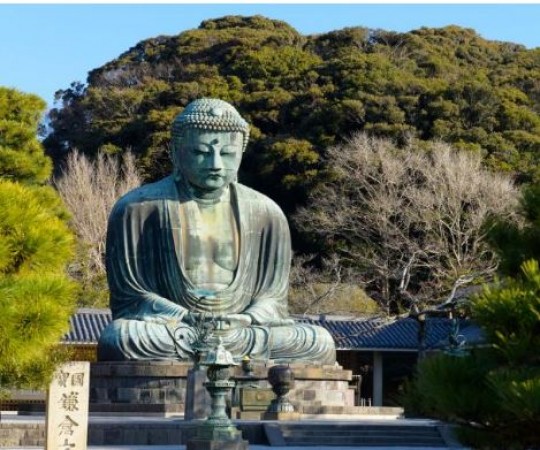
Kotoku-in Temple, located in Kamakura, Japan, is an iconic Buddhist temple that has captured the hearts of visitors from around the world. This historic temple is renowned for housing the majestic Great Buddha of Kamakura, an awe-inspiring bronze statue that stands as a symbol of peace, wisdom, and serenity.
Kotoku-in Temple was established in the late 13th century, during the Kamakura period, which lasted from 1185 to 1333. The temple was originally constructed in 1252, and its primary purpose was to serve as a center for the Buddhist sect known as Jodo-shu. The sect was founded by the esteemed Buddhist priest Honen, who advocated the belief that all sentient beings could attain enlightenment through reciting the name of Amitabha Buddha.
Also Read: Pilgrims Gather at Fatima Shrine to Receive Pope Francis's Blessings
Over the centuries, Kotoku-in Temple has experienced its share of turmoil and natural disasters. Nonetheless, it has remained a spiritual haven for countless devotees and tourists alike.
The most iconic feature of Kotoku-in Temple is undoubtedly the Great Buddha of Kamakura. The statue, also known as Daibutsu, is a monumental bronze representation of Amida Buddha, the Buddha of Infinite Light. Standing at an impressive height of approximately 43 feet (13 meters) and weighing around 93 tons, the Great Buddha is the second-largest bronze Buddha statue in Japan, second only to the one in Nara's Todai-ji Temple.
The construction of the Great Buddha dates back to 1252, and it was initially housed within a massive wooden hall. However, the hall was destroyed multiple times due to natural disasters, including a typhoon in the 14th century and a tidal wave in the 15th century. Consequently, the statue was left exposed to the elements, and it has remained in its open-air setting ever since.
Also Read: Ayodhya Ram Temple Bhumi Pujan: An Occasion Signifying Unity, Faith
Despite its tumultuous history, the Great Buddha has become a symbol of resilience, inner strength, and peace. Visitors are often struck by its serene expression and the sense of tranquility it exudes, making it an essential pilgrimage site for Buddhists and an inspiring destination for tourists seeking a moment of reflection.
Beyond the Great Buddha, Kotoku-in Temple boasts other architectural marvels that reflect the beauty of traditional Japanese craftsmanship. The temple grounds feature picturesque gardens, stone lanterns, and wooden gates, offering visitors a glimpse into Japan's rich cultural heritage.
Also Read: White Horse Temple: A Historical and Cultural Icon of China
One such remarkable structure is the Nandaimon Gate, the main entrance to the temple. This imposing wooden gate is adorned with intricate carvings and provides a sense of reverence as visitors pass through it to reach the Great Buddha. The gate's guardians, known as Ni-O, stand watch on either side, protecting the temple from evil spirits and impurities.
Inside the temple precincts, visitors can also find the Okuno-in, a sacred area where they can offer prayers and light incense sticks as a sign of respect and devotion to the Buddha. The experience of partaking in these rituals adds to the spiritual atmosphere and connects visitors with the temple's long-standing traditions.
Kotoku-in Temple holds immense cultural and historical significance in Japan. Its enduring presence and architectural beauty are a testament to the country's artistic and religious heritage. The temple's serene environment and connection to Buddhism attract millions of tourists, both domestic and international, seeking a deeper understanding of Japanese spirituality and a moment of tranquility amid their busy lives.
Also Read: Famen Temple: A Journey through Time and Spirit
To preserve its cultural treasures and maintain its spiritual sanctity, the temple relies on visitor donations and support from various organizations. These funds are utilized for ongoing maintenance and conservation efforts to ensure that future generations can continue to marvel at the beauty of Kotoku-in Temple and its Great Buddha.
Kotoku-in Temple is open to the public throughout the year, welcoming visitors from all walks of life. Travelers can reach Kamakura conveniently from Tokyo, making it an accessible day trip from the capital city. Upon arrival, visitors can explore the temple grounds, learn about its history through informative plaques, and soak in the spiritual ambiance that surrounds them.
Also Read: Maya Devi Temple, Lumbini: Discovering the Sacred Birthplace of Lord Buddha
While visiting the temple, it is essential to respect local customs and traditions. This includes adhering to the temple's rules, such as not touching the Great Buddha and dressing modestly as a sign of respect to the sacred site.
Kotoku-in Temple in Kamakura, Japan, stands as an embodiment of peace, wisdom, and cultural heritage. The Great Buddha of Kamakura remains an awe-inspiring testament to Japan's rich history and spirituality, inviting travelers from across the globe to bask in its serenity and find a moment of respite in a bustling world. The temple's enduring presence and captivating architecture continue to make it a beloved destination for those seeking solace and a deeper connection to the essence of life.
Also Read: Pashupatinath Temple: Nepal's Spiritual and Cultural Gem
From Bangalore to Pondicherry, Here Are Seven Places to Visit in Tamil Nadu
Hollywood Sikh Temple: Promoting Interfaith Dialogue and Understanding